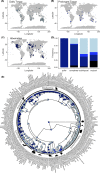Rare and Opportunistic Use of Torpor in Mammals-An Echo from the Past?
- PMID: 37328423
- PMCID: PMC10714912
- DOI: 10.1093/icb/icad067
Rare and Opportunistic Use of Torpor in Mammals-An Echo from the Past?
Abstract
Torpor was traditionally seen as a winter survival mechanism employed by animals living in cold and highly seasonal habitats. Although we now know that torpor is also used by tropical and subtropical species, and in response to a variety of triggers, torpor is still largely viewed as a highly controlled, seasonal mechanism shown by Northern hemisphere species. To scrutinize this view, we report data from a macroanalysis in which we characterized the type and seasonality of torpor use from mammal species currently known to use torpor. Our findings suggest that predictable, seasonal torpor patterns reported for Northern temperate and polar species are highly derived forms of torpor expression, whereas the more opportunistic and variable forms of torpor that we see in tropical and subtropical species are likely closer to the patterns expressed by ancestral mammals. Our data emphasize that the torpor patterns observed in the tropics and subtropics should be considered the norm and not the exception.
© The Author(s) 2023. Published by Oxford University Press on behalf of the Society for Integrative and Comparative Biology.
Conflict of interest statement
The authors have no conflicts of interests to declare related to this manuscript.
Figures


References
-
- Aschoff J. 1963. Comparative physiology: diurnal rhythms. Annu Rev Physiol. 25:581–600. - PubMed
-
- Barker JM, Cooper CE, Withers PC, Cruz-Neto AP. 2012. Thermoregulation by an Australian murine rodent, the ash-grey mouse (Pseudomys albocinereus). Comp Biochem Physiol A Mol Integr Physiol. 163:336–42. - PubMed
-
- Barnes BM. 1989. Freeze avoidance in a mammal: body temperatures below 0°C in an arctic hibernator. Science. 244:1593–5. - PubMed
-
- Bennett A, Ruben J. 1979. Endothermy and activity in vertebrates. Science. 206:649–54. - PubMed
-
- Boursot P, Din W, Anand R, Darviche D, Dod B, Von Deimling F, Talwar GP, Bonhomme F. 1996. Origin and radiation of the house mouse: mitochondrial DNA phylogeny. J Evolution Biol. 9:391–415.
Publication types
MeSH terms
Grants and funding
LinkOut - more resources
Full Text Sources
Miscellaneous

